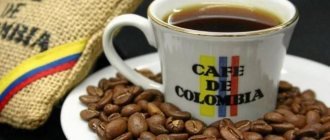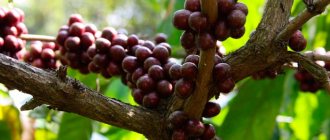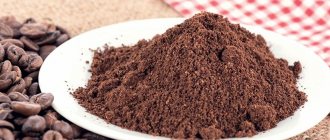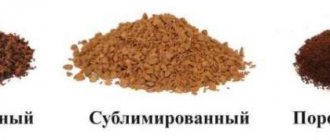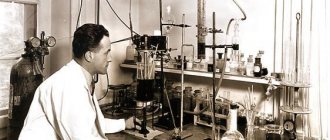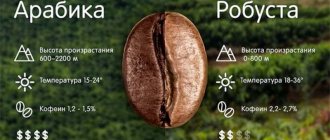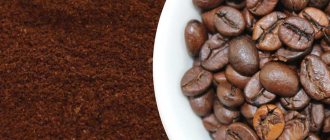Where did it all start?
Arabica is one of the botanical varieties of the coffee tree. Its official “name” sounds laconic: Coffea Arabica or Arabian Arabica.
Almost an Arabian fairy tale
The homeland of Arabica is Africa. More precisely, Ethiopia, and more precisely, the area between Kenya, Ethiopia and Sudan. It can be said with relative certainty that by the 9th century, coffee beans gained popularity in Ethiopia and the surrounding areas among shepherds, monks, pilgrims, and warriors. They all ate the fruits and grains of the plant, knowing about its stimulating properties. They were mixed with fat, boiled in hot water and simply chewed like regular berries.
The properties of coffee attracted the attention of Arab traders, and they decided to introduce this plant to their homeland.
There were active trade links between the Ethiopian market city of Harar and the Arabian Peninsula. It was from there that coffee came to Yemen, and from there to the Arab world.
At that time, the coffee tree was not yet called Arabica; this name was given to the plant by botany much later, and not entirely correct. They believed that the tree was an original inhabitant of Arabia, hence the name. Only later did it become clear that the plant’s ancestral home was Africa, but nothing was changed.
Arabica is one botanical species in which there are divisions into varieties or subspecies. The Arabs brought a variety to Arabia that is now called Typica. In addition to it, other subspecies of Arabica have grown and continue to grow in Africa. For example, Geisha (Gesha), which came to Latin America only in the 20th century and caused a real sensation.
Let's go back to the period when the Arabs first exported coffee from Ethiopia. Typica has taken root well on the Arabian Peninsula. The Arabs jealously guarded their secret, but after several centuries the plant still found its way to India, then to Europe. From there, the colonists took Typica to South America.
American adventures
In America, the newcomer took root well, but over time, the conditions of the new habitat caused changes in the structure and characteristics of the plant. Mutations began to appear. This first happened on the island of Bourbon, around the 18th century. The new subspecies was distinguished by the color of young shoots, a denser arrangement of branches and had a yield that was a third higher.
In honor of the island on which it was first discovered, the new subspecies was named “bourbon.”
In its historical homeland, Arabica is not prone to mutations. In Ethiopia and Yemen, which has a similar climate, the same old varieties grow safely, new ones appear only as a result of selection. But plantations on the new continent present more and more surprises.
New time
In the 20th century, Arabica continued to adapt to new conditions. At the beginning of the 20th century, a new subspecies was discovered in several countries of Central and South America, which had an even smaller distance between the branches, produced more yield, but most importantly, had a higher resistance to disease than its ancestor. They called him Caturra.
In the 1940s, Mundo Novo was born as a result of a natural cross between old Typica and new bourbon.
Next, another typica mutation was discovered, which was distinguished by the large size of porous and fragile grains. The variety was named Maragodzhip.
One of the most valuable mutations of Typica is Blue Mountain, which appeared as a result of cultivation at high altitudes, from 1800 meters above sea level.
Typica, Bourbon, Caturra and many of their descendants are subspecies of the same botanical species of coffee tree - Coffea Arabica. Many of them are obtained as a result of natural mutations, others as a result of cultivation. But they all belong to the same species.
Differences between Arabica and Robusta
These two types of roasted beans are most often seen on shelves and in coffee shops. Often, ground Arabica and Robusta beans are combined in different blends to increase the caffeine content of the drink. Several important features of the varieties:
Read also: The meaning of the word SOPKA. What is SOPKA?
| Arabica | Robusta | |
| Name in Latin | Coffea Arabica | Coffea Robusta |
| Growth | Ethiopia | Central continental Africa |
| Tree height | From 3 to 5 meters | Up to 13 meters |
| Growing distance above sea level | 600-2500 meters | 200-900 meters |
| Suitable temperature for fruit formation | +15 — +24 °С | +24 — +30 °С |
| Prone to disease and damage from pest attacks | Low | Increased |
| Varieties from this species | Bourbon, Mocha, Typica | Nana, Kouilou |
| Taste characteristics | The taste is sour, slightly astringent and refined | Strong, noticeably astringent and quite strong |
| Caffeine concentration per 250 ml cup | 0,65-2% | 1-3% |
| The presence of chlororenic acids providing viscosity and bitterness | 6,5% | 10% |
| Amount of glucose | Up to 8% | Up to 5 |
| Oils and fatty connectives | Before 18% | Up to 8-9% |
| Cost price | High | Low |
| Share in global production | Up to 70% | Up to 30% |
| Where is it used? | In mixtures for the production of various coffee drinks, in the form of single varieties | For the production of instant coffee, as an additive to more expensive varieties |
How does it grow?
This type of coffee tree is quite capricious. He needs special conditions
- Scattered rays of the sun.
- Constant flow of fresh warm air.
- Regular but moderate supply of moisture.
- Special soil composition, with a balance of organic and mineral substances.
Due to the burning direct rays of the sun in South and Central America, the plant is planted under the canopy of local trees. Tall and spreading neighbors scatter the hot rays and cover capricious coffee trees from gusts of wind and heavy rainfall.
Flowers, fruits, seeds...
Coffea Arabica grows in warm climates, so it does not have a state of absolute dormancy. On the same tree you can simultaneously observe buds, flowers and berries in different degrees of ripeness.
It blooms with beautiful, large white flowers. They are located in the axils of the leaves. You don’t have to admire their aroma and beauty for a long time, since the flowering period lasts only a couple of days. Then the flowers fly around, and fruits form in place of the ovaries. They ripen for quite a long time, up to 9 months. During the ripening process they change color from green to red. When ripe, they look like clusters of scarlet berries with a glossy surface. Their pulp is juicy and sweet; it is not without reason that many animals and birds love to feast on these fruits.
Inside the berry there is a bilobed stone. After processing, roasting and grinding, it ends up in our cezves and coffee makers.
The bone consists of two independent halves in the shape of an oval. In the berry they are closely pressed to each other, and after cleaning they fall apart. A dividing groove remains in each part. It is slightly curved and some pulp may remain in it.
Grain size and appearance
Another difference between Arabica and Robusta is external qualities (size, color, shape of grains). The following description will help you distinguish them:
- Arabica. It looks like an oval in shape. Size - 7–8 mm. After roasting they acquire a uniform brown color.
- Robusta. The shape resembles a circle. Size - less than 5–6 mm. The color does not become uniform after roasting. Its surface may include several shades of brown.
A photo will help you distinguish Arabica beans from cheaper counterparts. Look at the picture: one grain is elongated and large, the other is rounded and small.
The best coffee on earth
Once the berries are picked and cleaned, the seeds begin their own journey. They are called not by the botanical term - “seeds”, but by a more familiar name to our ears - “coffee beans”.
All coffee that matures on Arabica trees is also called Arabica. It may also have an additional varietal name, for example, Blue Mountain or Ethiopia Sidamo. That is, if the package with the name “Indonesia Mandeling” is marked as 100% Arabica, then there is no contradiction here. The pack contains the Mandeling variety, grown and harvested on plantations in Indonesia.
Historical reference
Arabica was mentioned in the 6th century. It was originally grown in Yemen and Ethiopia. The world was content with only these coffee berries until the beginning of the 20th century, only later did other species appear.
The historical homeland is the lowlands of the rivers of the Kefa Valley. There you can still see wild trees located 2000 meters above sea level.
At the end of the 19th century, many farmers were forced to stop cultivating the popular plant due to disease, and it was replaced by other crops. At the same time, they began to work on the Robusta type coffee tree in Indonesia. It had high yields and amazing resistance to disease, but the finished drink was of low quality.
In the first half of the 20th century, breeders carried out work in three directions to adapt the plant to cultivation in local conditions, while simultaneously increasing the yield and improving the quality of the drink. After 20 years, agronomists from different countries have adopted a plan that will help make Arabica more resistant to disease.
Features of taste
70% of all coffee consumed annually is Arabica. This popularity is explained by the taste of the grains. They are distinguished by a high content of essential oils and aromatic substances.
One of the important taste features is fruity sourness, which can be of varying intensity. The high content of sucrose in the grain is responsible for it. When roasting, sucrose decomposes into its constituent elements, including organic acids. Hence the piquant sourness.
The fruits of the tree have a high content of lipids - fat-containing substances. They make up up to 20% of the grain. Lipids are almost not destroyed during frying, and, according to scientists, they are responsible for the thick and rich aroma.
The caffeine content is 1.2-1.5%, which is almost half that of another type of coffee - robusta.
Arabica has an expressive aroma, a complex flavor profile with characteristic sourness and a relatively low strength.
In order to increase the caffeine content, Arabica beans are mixed with strong Robusta. Such mixtures are called blends or blends. They are especially actively used for making espresso. The packaging will definitely indicate the proportions of Arabica and Robusta, but the name of a specific variety is much less common. Blends can include Typica, Bourbon, Caturra, and Maragogipe in various proportions. Manufacturers most often limit themselves to indicating the country of origin of coffee raw materials: Guatemala, Ethiopia, Costa Rica.
Which one is the best?
Arabica can be of a high-class “specialty” type; such varieties are highly valued, expensive and have a rich taste and aroma. Coffee made from them has a recognizable bouquet. It is sold as single varieties and is rarely collected into blends and mixtures.
There is also low-grade Arabica. It has an inexpressive taste and low cost. It is used for blends, mixtures, the production of instant ersatz or for domestic use in some exporting countries with a low standard of living. Expensive varieties are exported, while substandard varieties are kept for themselves.
The inscription “100% Arabica” does not guarantee quality, it all depends on the specific varieties. There are decent examples in almost every country, but the best are those that grow at an altitude of 1500-1800 meters above sea level.
How to read labels correctly?
Let's try to figure out how to correctly “read” the labels on packs in the store.
- The packaging may indicate the percentage of beans of a particular botanical variety in a given finished product. The indication “100% Arabica” means that only this type was used to make the product.
- The pack may contain a “hodgepodge” or a blend. The coffee for it may be grown in one country, but the manufacturing company mixed different beans, roasted and packaged it. The packaging may proudly bear the mark “100% Arabica”, and this will be absolutely true. After all, all the grains for such a product grew on trees of the same botanical species.
- If you see a varietal name on a pack, for example, “Monsund Malobar” or “Yemen Matari”, then this is a single variety.
Healthy Arabica
Natural, fresh coffee benefits the body.
- Coffee gives you energy and joy, as caffeine increases dopamine levels. Even the smell of coffee alone stimulates the production of pleasure hormones.
- Caffeine not only improves mood, but also stimulates mental work, helping to concentrate, sharpens attention and reaction.
- Caffeine dilates blood vessels, this helps when you need to relieve muscle spasm, for example, with a headache.
- Caffeine stimulates blood circulation. Consuming coffee in reasonable quantities has a beneficial effect on the functioning of the cardiovascular system. Optimal caffeine content in Arabica. But you need to be careful with Robusta, as it has a high caffeine content.
- The antioxidants and phytonutrients found in grains may reduce the risk of developing chronic diseases. They also contribute to the destruction of abnormal, that is, cancerous, cells in the body.
- Lipids contained in coffee beans are a source of energy for cells and improve the absorption of vitamins. By the way, Arabica contains almost twice as many lipids as Robusta.
All the benefits of coffee can only be achieved if you drink it within reasonable limits. A reasonable amount is 1–2 cups of coffee per day. Of course, besides the benefits, coffee also has a downside.
Roasting
The finished product can have a variety of roasts, from light light to Italian dark, which gives the coffee a dark brown flavor and caramel aroma. The stronger the roast, the brighter the bitter note in the finished drink. This happens due to the strong caramelization of sugar, which, when burned, begins to taste bitter. Medium or light roast has a slight, almost imperceptible bitterness. But the sourness is more noticeable, but with strong heat treatment its taste is weaker due to the decomposition of organic acids under the influence of high temperatures.
What degree of roasting is best?
Medium roast reveals the flavor profile of the grain best. There are some varieties that are only consumed lightly roasted. Even if you are a fan of Italian roasting, you will have to come to terms with the fact that it is not recommended to roast the specialty class too much. Heat treatment greatly changes the taste, and not for the better.
Our conclusion
- Originated from Africa.
- It grows in the countries of the coffee belt.
- Requires care.
- Became the basis of most modern coffee varieties.
- All varieties of Arabica are still Arabica, even with different names.
- Good aroma and slight sourness in taste.
- Not very strong.
- The inscription “100% Arabica” is not a guarantee of quality.
- The best grows at high altitudes.
- Monosort is better than “hodgepodge”.
- The best roast for beans is medium.
Taste characteristics
Unlike other varieties of coffee, the berries of this plant, after processing, produce a drink with a slight sourness. Bitterness is weakly expressed. This is due to the low caffeine content.
Factors affecting taste
First of all, the composition of the soil and the climatic conditions in which the tree grew are important.
The taste of coffee depends on where the Arabica grows.
In addition, the method of collection and primary processing affects the quality. Ground coffee is less resistant to transportation than grain coffee. The taste of the product is also influenced by proper storage.
